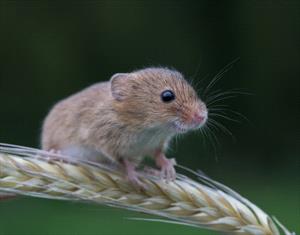Some of my favorite patients have been mice but I don't want a wild one loose in my home
Mouse on wheat blade

Photo courtesy of Depositphotos
“Umm, Mom! Tino’s playing with a mouse and I don’t think it’s a toy!”
This is not how one ever wants to start the day. Tino – short for Valentino, so named because he was such a lover boy and adopted near Valentine’s Day – had a mouse in the house. A live one. At least at the moment. He is one of my two cats. One of my two indoor-only cats. Sigh….
We live near grassy fields that have a lot of great wildlife. I often see deer and turkeys, hear crows and coyotes, and smell skunks in our area of California. It’s a full sensory experience! Having mice and ants in the home are normal side effects of our beautiful area, kind of like cockroaches in Florida; I lived there once and they are ubiquitous. Here, it’s ants and mice. Between them, I’ll take the ants and mice. But I digress.
As I went to verify that, yes, the cats had a real mouse, I asked “Can you help me? Grab a plastic container, a large one.” My teenager then looked at me with that look one expects from teenagers. No way. Help me when I have stray kittens? Sure. But a stray mouse? Not happening.
“I have to get to school. Bye!” I heard the door slam.
Now, I’m a veterinarian. I’m not squeamish around mice. Some of my favorite patients have been mice. But I didn’t want a wild one loose in my home. Actually, I wouldn’t want a domesticated one loose in my home either.
Trying to catch a live mouse from two cats is not easy. Every time I approached, they would pick up the mouse, carry it to a new room, and drop it again to continue their “playtime.” If I successfully stopped them from picking it up, the mouse would run under furniture or behind books, papers, or anything left on the floor. This went on for hours. Finally the poor thing was exhausted enough that I was able to get it away from both cats, catch it under a plastic container, and scoop it up for humane removal. In my brief visual exam, I was amazed to not see any blood. Hoping for the best, I released it in the field near some scrub bushes.
Times like this make me think about the interactions that humans have with all of the other species of animals. As a child, I read numerous books featuring mice as main characters. Some of my favorites were Stuart Little, The Mouse and the Motorcycle, and Santa Mouse. They were always depicted as cute and cuddly, somebody you’d want as a friend. As I mentioned earlier, mice have been some of my favorite patients during my veterinary career. They’re curious and fun to watch, often making them first pets for children. But as a homeowner, I do not want them in my house. I have a realistic and, I believe, healthy fear of the diseases they can carry and transmit to humans. Tularemia, hantavirus, and leptospirosis are just some of the more notable ones. Many of the diseases are spread in the droppings (feces) or urine of mice. So even if you never see the little guys, if they’re leaving behind evidence of their existence, it can be a problem. Should one of the cats have caught it and consumed it, that cat could have become sick as well. This was no time to let nature run its course, letting cats be cats. But still, it had me pondering the mindset of the species I am a part of, Homo sapiens. Why do we view animals with a different lens not based on the species but on how we feel about the individual in that moment?
Many animals are in the same category as mice: what we think of them and how we treat them depends on their intended use to us as humans. Our laws reflect this strange dichotomy. For instance, a rabbit that is a pet will likely fall under the usual state animal welfare laws, but a rabbit that is used in a laboratory setting falls under the federal Animal Welfare Act, and rabbits used for meat may not fall under any laws depending on how that state’s humane slaughter laws are written. One species, but the protections afforded it depend on its use by humans. If you’ll excuse the pun, it offers some food for thought.
Nevertheless, despite the adorable illustrations of Santa Mouse, I do not want them in my home where they can potentially spread diseases that people can get. They should remain outdoors where nature intended for them to live, eat, and poop.